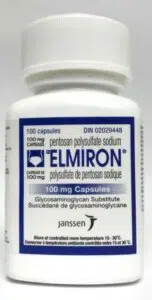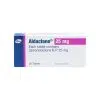No products in the cart.
Return To ShopElmiron
Elmiron (pentosan polysulfate sodium) is a specialized oral medication designed to treat bladder pain and discomfort associated with interstitial cystitis. This unique heparin-like compound works by potentially protecting the bladder wall from irritating substances in urine, though its exact mechanism remains under investigation. For patients seeking affordable urological medications, working with healthcare providers ensures proper diagnosis and monitoring, as interstitial cystitis requires specialized care and Elmiron needs regular medical supervision due to potential serious side effects including retinal changes and bleeding complications.
- Prescription Required
| Brand | Form | Price | Qty | Action |
|---|---|---|---|---|
| Elmiron Brand | 100mg 100 Capsules | $440.00 |
- Please note all prices are in US dollars
Elmiron (pentosan polysulfate sodium) represents a unique therapeutic approach to managing interstitial cystitis, a chronic and often debilitating bladder condition that affects millions of people worldwide. As the only FDA-approved oral medication specifically indicated for interstitial cystitis bladder pain, Elmiron offers hope for patients who have struggled with conventional treatments and lifestyle modifications.
Pentosan polysulfate sodium is a semi-synthetic heparin-like macromolecular carbohydrate derivative that structurally resembles naturally occurring glycosaminoglycans found in healthy bladder tissue. With a molecular weight ranging from 4,000 to 6,000 Daltons, this compound demonstrates unique properties that may help restore the protective barrier function of the bladder wall, which is often compromised in patients with interstitial cystitis.
Mechanism of Action and Bladder Protection: While the exact mechanism by which Elmiron provides relief remains incompletely understood, research suggests the medication adheres to the bladder wall mucosal membrane, potentially acting as a buffer to control cell permeability. This protective action may prevent irritating solutes in urine from reaching sensitive bladder wall cells, thereby reducing the pain and urgency symptoms characteristic of interstitial cystitis.
The medication’s heparin-like structure allows it to potentially replenish defective or damaged glycosaminoglycan layers in the bladder wall. In healthy individuals, this protective layer serves as a crucial barrier between urine and the underlying bladder tissues. In interstitial cystitis patients, this protective barrier is often compromised, leading to inflammation, pain, and the characteristic symptoms of urgency and frequency.
Clinical Research and Effectiveness: Elmiron’s efficacy has been demonstrated in controlled clinical trials involving thousands of patients. In a pivotal randomized, placebo-controlled study of 151 patients, 38% of those receiving Elmiron showed greater than 50% improvement in bladder pain compared to only 18% of placebo recipients. This statistically significant difference (p = 0.005) established Elmiron’s role as an effective treatment option for interstitial cystitis.
A larger physician usage study involving 2,499 patients provided additional insights into real-world effectiveness and optimal treatment duration. By three months, 29% of patients experienced significant pain improvement, with additional patients showing improvement at six months. These studies revealed that while some patients experience relief relatively quickly, optimal benefits often require several months of consistent treatment.
Pharmacokinetic Profile and Absorption: Elmiron demonstrates unique pharmacokinetic properties that support its therapeutic application. Approximately 6% of an oral dose reaches systemic circulation, with peak plasma levels occurring around 2 hours after administration. The medication undergoes partial metabolism in the liver and spleen through desulfation, and partial depolymerization in the kidneys, creating multiple active metabolites.
The drug’s distribution pattern shows preferential accumulation in uroepithelial tissues of the genitourinary tract, exactly where its therapeutic action is needed. Lesser amounts distribute to liver, spleen, lung, skin, and bone marrow, while erythrocyte penetration remains low. This selective distribution supports the medication’s targeted approach to bladder protection.
Long-term Treatment Considerations: Interstitial cystitis is typically a chronic condition requiring long-term management. Elmiron is designed for extended use, with many patients requiring months to years of treatment to maintain symptom control. The medication’s safety profile supports long-term use, though recent concerns about retinal pigmentary changes have led to enhanced monitoring recommendations.
Important Safety Monitoring: Recent studies have identified potential retinal pigmentary changes (pigmentary maculopathy) associated with long-term Elmiron use, particularly after three or more years of treatment. While most cases occurred with extended use, some have been reported with shorter durations. These findings have led to updated recommendations for baseline and periodic ophthalmologic examinations to monitor for retinal changes.
For patients managing complex urological conditions, Elmiron offers significant therapeutic potential when used appropriately under medical supervision. Those exploring treatment options for chronic bladder pain should work with urologists or other specialists experienced in interstitial cystitis management. Patients seeking cost-effective treatment options should understand that while Elmiron represents a specialized therapy, proper medical monitoring is essential for safe long-term use. The medication requires patience, as therapeutic benefits often develop gradually over months, and patients should maintain realistic expectations while working closely with healthcare providers to optimize treatment outcomes and monitor for potential complications.
| Brand | Elmiron Brand |
|---|---|
| Form | 100mg 100 Capsules |
Elmiron can cause various side effects ranging from common, mild reactions to serious complications requiring medical attention. Understanding these potential effects is crucial for safe treatment, particularly given the medication's unique mechanism and need for long-term use in many patients.
Most Common Side Effects (>1% of patients):
- Alopecia (hair loss) - 4%: Usually presents as alopecia areata affecting single scalp areas, typically beginning within first 4 weeks
- Diarrhea - 4%: Mild to moderate gastrointestinal upset, usually manageable with supportive care
- Nausea - 4%: May improve with food timing adjustments or anti-nausea medications
- Headache - 3%: Generally mild to moderate intensity, often transient
- Rash - 3%: Various skin manifestations, usually mild and self-limiting
- Dyspepsia - 2%: Indigestion or upper abdominal discomfort
- Abdominal pain - 2%: Lower abdominal cramping or discomfort
- Dizziness - 1%: Mild vertigo or balance disturbances
- Liver function abnormalities - 1%: Elevated liver enzymes, usually transient
Gastrointestinal Side Effects:
- Vomiting: Less common than nausea, may require medication adjustments
- Mouth ulcers: Painful oral lesions requiring supportive care
- Colitis: Inflammatory bowel condition requiring medical evaluation
- Esophagitis: Esophageal inflammation potentially related to medication irritation
- Gastritis: Stomach lining inflammation causing pain and discomfort
- Flatulence: Increased intestinal gas production
- Constipation: Reduced bowel movement frequency
- Anorexia: Decreased appetite affecting nutritional intake
Serious Bleeding-Related Side Effects:
- Rectal hemorrhage - 6.3%: Most common bleeding complication at standard 300mg daily dose
- Gum hemorrhage: Bleeding gums during brushing or spontaneously
- Ecchymosis: Easy bruising from minor trauma
- Epistaxis: Nosebleeds of varying severity
- Increased bleeding times: Prolonged bleeding from cuts or surgical procedures
- Anemia: Potentially resulting from chronic blood loss
- Thrombocytopenia: Decreased platelet counts affecting clotting
Critical Retinal Side Effects (Serious Warning):
- Pigmentary maculopathy: Pigment changes in retinal tissue, potentially irreversible
- Difficulty reading: Reduced visual acuity affecting reading ability
- Slow light adaptation: Delayed adjustment to low or reduced lighting conditions
- Blurred vision: Decreased visual clarity affecting daily activities
- Retinal hemorrhage: Bleeding within retinal tissues
- Optic neuritis: Inflammation of optic nerve affecting vision
- Amblyopia: Reduced vision not correctable with glasses
Hematologic (Blood-Related) Side Effects:
- Increased prothrombin time: Prolonged blood clotting times
- Increased partial thromboplastin time: Enhanced anticoagulation effects
- Leukopenia: Decreased white blood cell counts
- Anemia: Reduced red blood cell levels from bleeding or other causes
- Factor Xa inhibition: Altered coagulation cascade function
- Platelet aggregation inhibition: Reduced platelet clumping ability
Hepatic (Liver-Related) Effects:
- Elevated transaminases: Increased ALT/AST levels indicating liver stress
- Alkaline phosphatase elevation: Elevated enzyme levels suggesting liver involvement
- Gamma-glutamyl transpeptidase increase: Additional liver enzyme elevation
- Lactic dehydrogenase elevation: Non-specific enzyme increase
- Liver function test abnormalities: Various hepatic parameter changes
Hypersensitivity and Allergic Reactions:
- Allergic reactions: Various immune-mediated responses
- Photosensitivity: Increased sensitivity to sunlight exposure
- Pruritus: Generalized or localized itching
- Urticaria: Hives or raised skin welts
- Contact dermatitis: Skin inflammation from direct contact
Respiratory System Effects:
- Pharyngitis: Sore throat and throat inflammation
- Rhinitis: Nasal congestion and runny nose
- Dyspnea: Shortness of breath or breathing difficulties
- Epistaxis: Nosebleeds related to anticoagulant effects
Neurological and Sensory Effects:
- Insomnia: Difficulty falling or staying asleep
- Depression/emotional lability: Mood changes or emotional instability
- Nystagmus: Involuntary eye movements
- Hyperkinesia: Excessive or abnormal movements
- Conjunctivitis: Eye inflammation and irritation
- Tinnitus: Ringing or buzzing in ears
Reproductive and Genitourinary Effects:
- Amenorrhea: Absence of menstrual periods
- Vaginitis: Vaginal inflammation or infection
- Genitourinary symptoms: Various urological complications
Dose-Dependent Side Effects:
- Higher dose complications: At 900mg daily (above approved dose), rectal hemorrhage increased to 15%
- Liver function abnormalities: At higher doses, 11.8% vs 2% placebo rate
- Cumulative toxicity: Risk increases with longer treatment duration
Long-term Treatment Complications:
- Retinal pigmentary changes: Risk increases with cumulative dose and duration
- Chronic bleeding issues: Ongoing hemorrhagic complications
- Hepatic monitoring needs: Regular liver function assessment required
- Hematologic surveillance: Blood count monitoring for abnormalities
Drug Interaction-Related Effects:
- Enhanced anticoagulation: Increased bleeding risk with warfarin, heparin, or aspirin
- NSAID interactions: Additive bleeding effects with anti-inflammatory medications
- Surgical complications: Increased bleeding during procedures
Monitoring Requirements for Side Effect Detection:
- Ophthalmologic examinations: Baseline and periodic retinal assessments with OCT and auto-fluorescence imaging
- Complete blood counts: Regular monitoring for anemia, thrombocytopenia, leukopenia
- Liver function tests: Periodic assessment of hepatic enzymes and function
- Coagulation studies: PT/PTT monitoring in high-risk patients
- Clinical symptom assessment: Regular evaluation for bleeding, vision changes, pain relief
Emergency Warning Signs:
- Sudden vision changes: Immediate ophthalmologic evaluation needed
- Severe bleeding: Heavy rectal bleeding, significant bruising, or prolonged bleeding
- Signs of liver dysfunction: Jaundice, severe abdominal pain, dark urine
- Severe allergic reactions: Difficulty breathing, facial swelling, severe rash
- Neurological symptoms: Severe dizziness, confusion, or coordination problems
Critical Safety Note: The most serious concern with Elmiron is the potential for irreversible retinal pigmentary changes, which may continue to progress even after stopping the medication. All patients require baseline and regular ophthalmologic monitoring throughout treatment. Additionally, the medication's anticoagulant properties require careful consideration in patients with bleeding risks or those taking other blood-thinning medications.
Elmiron (pentosan polysulfate sodium) has a specific FDA-approved indication for treating bladder pain and discomfort associated with interstitial cystitis, representing the only oral medication specifically approved for this challenging urological condition based on extensive clinical research and regulatory review:
Primary FDA-Approved Indication:
Interstitial Cystitis Bladder Pain Relief:
- Classic interstitial cystitis: Chronic bladder pain syndrome with characteristic cystoscopic findings
- Painful bladder syndrome: Bladder pain without visible cystoscopic abnormalities
- Bladder pain syndrome/interstitial cystitis (BPS/IC): Comprehensive diagnosis including pain, pressure, or discomfort in bladder region
- Chronic pelvic pain: When specifically related to bladder origin and meeting IC diagnostic criteria
Diagnostic Requirements for Elmiron Use:
- NIH diagnostic criteria: Patients must meet established National Institutes of Health definition of interstitial cystitis
- Cystoscopic examination: Bladder inspection to rule out other conditions and assess characteristic changes
- Urinary cytology: Microscopic examination to exclude malignancy or infectious causes
- Bladder biopsy: Tissue examination to confirm diagnosis and rule out other pathology
- Symptom duration: Chronic symptoms present for appropriate timeframe as determined by clinical guidelines
Clinical Evidence Supporting Approval:
Pivotal Clinical Trial Results:
- Randomized controlled study: 151 patients (145 women, 5 men) with mean age 44 years
- Treatment duration: 3 months of Elmiron 100mg three times daily versus placebo
- Primary endpoint: Greater than 50% improvement in bladder pain based on patient assessment
- Efficacy results: 38% of Elmiron patients vs 18% of placebo patients achieved primary endpoint
- Statistical significance: p = 0.005, demonstrating clinically meaningful and statistically significant benefit
Large-Scale Physician Usage Study:
- Study population: 2,499 patients (2,220 women, 254 men, 25 unknown gender)
- Patient demographics: Mean age 47 years, 23% over 60 years of age
- Treatment regimen: 300mg daily (100mg three times daily) without blinding
- Follow-up duration: Prospectively designed analysis with evaluations every 3 months
- Retention rates: 48% completed 3 months, 36% completed 6 months, 24% completed 1 year
Dosing and Administration Protocol:
Standard Dosing Regimen:
- Recommended dose: 300mg daily divided as 100mg three times daily
- Administration timing: With water at least 1 hour before meals or 2 hours after meals
- Meal considerations: Empty stomach administration for optimal absorption
- Dose adjustments: No specific dose modifications for age, gender, or mild organ impairment
Treatment Duration Guidelines:
- Initial assessment period: 3 months of consistent treatment before efficacy evaluation
- Extended trial period: Additional 3 months if initial improvement insufficient but adverse events acceptable
- Long-term treatment: Continued use based on individual response and risk-benefit assessment
- Treatment cessation: Clinical value and risks of continued treatment beyond 6 months require careful evaluation
Patient Selection Criteria:
Ideal Candidates for Elmiron:
- Confirmed IC diagnosis: Meeting established diagnostic criteria with appropriate exclusions
- Chronic pain duration: Persistent bladder pain lasting months to years
- Failed conservative treatments: Inadequate response to dietary modifications, bladder training, stress management
- Significant quality of life impact: Pain affecting daily activities, sleep, relationships, or work productivity
- Commitment to monitoring: Ability to maintain regular medical follow-up and monitoring requirements
Clinical Assessment Requirements:
- Comprehensive urological evaluation: Complete history and physical examination
- Baseline ophthalmologic examination: Retinal assessment before treatment initiation
- Laboratory studies: Baseline liver function, complete blood count, coagulation studies
- Bladder symptom scoring: Validated instruments to assess pain severity and urinary symptoms
- Quality of life assessment: Functional impact evaluation using standardized measures
Contraindications and Precautions:
Absolute Contraindications:
- Hypersensitivity: Known allergy to pentosan polysulfate sodium or any formulation components
- Structural sensitivities: Allergy to structurally related heparin-like compounds
- Excipient allergies: Sensitivity to inactive ingredients in the formulation
How long does it take for Elmiron to start working?
Elmiron typically requires patience, as improvement often develops gradually over several months. In clinical studies, some patients noticed improvement within the first few weeks, but many required 3-6 months of consistent treatment to experience significant pain relief. About 29% of patients showed meaningful improvement by 3 months, with additional patients improving by 6 months. After 6 months, fewer than 1.5% of patients experience their first onset of pain relief, so most patients who will respond do so within the first 6 months of treatment.
Do I need to take Elmiron for life?
The duration of Elmiron treatment depends on your individual response and the chronic nature of interstitial cystitis. Many patients require long-term treatment to maintain symptom control, as stopping the medication often results in return of bladder pain. Your doctor will reassess your condition after 3 months, and if you haven't improved but aren't experiencing limiting side effects, treatment may continue for another 3 months. The benefits and risks of treatment beyond 6 months should be carefully evaluated with your healthcare provider.
What are the serious eye problems associated with Elmiron?
Elmiron can cause pigmentary changes in the retina, known as pigmentary maculopathy, which may be irreversible even after stopping the medication. These changes typically occur after 3 years of use but can happen sooner. Symptoms include difficulty reading, slow adjustment to low light, and blurred vision. All patients need baseline eye exams with specialized imaging (OCT and auto-fluorescence) within 6 months of starting treatment, followed by regular monitoring exams. If retinal changes develop, the risks and benefits of continuing treatment must be carefully reconsidered.
Why does Elmiron increase bleeding risk?
Elmiron has anticoagulant properties similar to heparin, though about 15 times weaker. It affects blood clotting by inhibiting factor Xa generation and reducing platelet aggregation. The most common bleeding issue is rectal hemorrhage, occurring in about 6% of patients at the standard 300mg daily dose. You're at higher risk if you take blood thinners like warfarin, high-dose aspirin, or anti-inflammatory medications. Always inform doctors about Elmiron use before surgeries or procedures.
Can I take Elmiron with other medications?
Elmiron can interact with other medications, particularly those affecting blood clotting. Be especially cautious with warfarin, heparin, high-dose aspirin, and NSAIDs like ibuprofen, as these can increase bleeding risk. Always inform all healthcare providers about your Elmiron use before starting new medications or having procedures. While studies show minimal interaction with warfarin at therapeutic doses, individual responses can vary, and your doctor may need to monitor your clotting times more closely.
What should I do about hair loss from Elmiron?
Hair loss affects about 4% of patients and typically begins within the first 4 weeks of treatment. Most cases (97%) are alopecia areata, affecting single areas on the scalp rather than overall thinning. The hair loss is usually related to the medication's heparin-like properties. While concerning cosmetically, this side effect is generally reversible when the medication is stopped, though recovery may take several months. Discuss with your doctor if hair loss becomes significant or bothersome.
How should I take Elmiron for best results?
Take Elmiron exactly as prescribed - typically one 100mg capsule three times daily with water, at least 1 hour before meals or 2 hours after eating. Taking it on an empty stomach ensures optimal absorption. Maintain consistent timing throughout the day and don't skip doses, as steady levels are important for effectiveness. If you miss a dose, take it as soon as you remember, but don't double up on doses to make up for missed ones.
Is Elmiron safe during pregnancy and breastfeeding?
Elmiron should only be used during pregnancy if clearly needed, as adequate human studies haven't been conducted. Animal studies at doses similar to human use didn't show harmful effects, but direct studies on cultured mouse embryos suggested potential limb development issues at high concentrations. It's unknown whether Elmiron passes into breast milk, so caution is advised during nursing. Discuss pregnancy plans or current pregnancy with your doctor to weigh benefits against potential risks.
What liver problems can Elmiron cause?
Elmiron can cause mild elevations in liver enzymes in about 1.2% of patients, typically appearing 3-12 months after starting treatment. These increases usually aren't associated with jaundice or symptoms and may be transient, remain stable, or rarely progress. Higher doses increase this risk - at 900mg daily (above the approved dose), 11.8% of patients experienced elevated liver tests. Regular monitoring helps detect liver changes early, and most patients can continue treatment safely with monitoring.
Can I use Elmiron if I have other bladder medications?
Elmiron can often be used alongside other interstitial cystitis treatments like bladder instillations or other urological medications. However, coordinate all treatments with your urologist to ensure compatibility and optimal timing. Some patients benefit from combination approaches including dietary modifications, physical therapy, and other bladder-protective strategies. Your healthcare team can help design a comprehensive treatment plan that maximizes benefits while minimizing risks.
What monitoring do I need while taking Elmiron?
Regular monitoring includes baseline and periodic eye exams with specialized retinal imaging, liver function tests, and blood counts to check for anemia or clotting abnormalities. Eye exams should occur within 6 months of starting treatment and continue periodically throughout therapy. Blood tests may be needed every few months initially, then less frequently once stable. Report any vision changes, unusual bleeding, or abdominal pain immediately to your healthcare provider.
Why might Elmiron stop working over time?
While some patients maintain long-term benefit from Elmiron, others may experience reduced effectiveness over time. This could be due to disease progression, development of tolerance, or other factors affecting interstitial cystitis. If pain relief diminishes, don't increase the dose on your own - consult your doctor about adjusting treatment strategy. Sometimes combining Elmiron with other therapies or addressing contributing factors can restore effectiveness.
What should I know about stopping Elmiron?
Don't stop Elmiron abruptly without consulting your doctor, as this puts treatment success at risk and symptoms typically return. If side effects develop or treatment isn't helping after adequate trial periods, work with your healthcare provider to develop a tapering plan if needed. Some patients may need to stop due to retinal changes or bleeding complications, and your doctor can help transition to alternative treatments while managing symptom recurrence.
How do I know if Elmiron is right for my type of bladder pain?
Elmiron is specifically indicated for interstitial cystitis bladder pain, which requires proper diagnosis through cystoscopy, symptom assessment, and ruling out other conditions. The medication works best for true interstitial cystitis rather than other causes of bladder pain like infections, stones, or cancer. Your urologist can determine if your symptoms and diagnostic findings make you a good candidate for Elmiron therapy based on established criteria and treatment guidelines.
The content on this page has been supplied to telavivpharma.com by an independent third party contracted to provide information for our website. telavivpharma.com relies on these third parties to create and maintain this information and cannot guarantee the accuracy or reliability of the information that has been provided to us.
The drug information provided here is only a summary and does not contain all the list of possible side effects and drug interactions regarding this medication. Be sure to contact your doctor or pharmacist if you have any specific question or concern. If you require any advice or information about the drugs on this page, a medical condition or treatment advice, you should always speak to a healthcare professional.
Please note that not all products, including any referenced in this page, are shipped by our affiliated Israel Pharmacy. We are affiliated with other dispensaries that ship product to our customers from the following jurisdictions: Canada, New Zealand, Turkey and United Kingdom. The items in your order maybe shipped from any of the above jurisdictions. The products are sourced from various countries as well as those listed above. Rest assured, we only affiliate with our authorized dispensaries that procure product through reliable sources.
Required
Send Your Prescription
Secure Payment
No Hidden Fees
Fast Shipping
Typically Under 7 days





Reviews
There are no reviews yet.